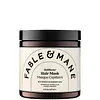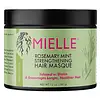What's inside
What's inside
 Key Ingredients
Key Ingredients

 Benefits
Benefits

 Concerns
Concerns

 Ingredients Side-by-side
Ingredients Side-by-side

Water
Skin ConditioningAloe Barbadensis Leaf Juice
Skin ConditioningBehentrimonium Chloride
PreservativeGlycerin
HumectantLimnanthes Alba Seed Oil
Skin ConditioningCetearyl Alcohol
EmollientTheobroma Cacao Seed Butter
EmollientButyrospermum Parkii Butter
Skin ConditioningParfum
MaskingGlyceryl Stearate
EmollientCetyl Alcohol
EmollientTocopherol
AntioxidantTocopheryl Acetate
AntioxidantBacopa Monnieri Extract
Skin ConditioningEclipta Prostrata Extract
Skin ConditioningCitrus Aurantium Dulcis Fruit Extract
MaskingCitrus Limon Fruit Extract
MaskingCurcuma Longa Root Extract
MaskingMusa Sapientum Fruit Extract
Skin ConditioningWithania Somnifera Root Extract
Skin ConditioningEmblica Officinalis Fruit Extract
Skin ConditioningAcer Saccharum Extract
Skin ConditioningHibiscus Sabdariffa Flower Extract
Skin ConditioningGmelina Arborea Root Extract
Skin ConditioningOroxylum Indicum Root Extract
Skin ConditioningPremna Serratifolia Root Extract
Skin ConditioningSolanum Indicum Root Extract
Skin ConditioningSolanum Xanthocarpum Root Extract
MaskingStereospermum Suaveolens Root Extract
Skin ConditioningTribulus Terrestris Root Extract
Skin ConditioningSaccharum Officinarum Extract
MoisturisingTrigonella Foenum-Graecum Seed Extract
PerfumingVaccinium Myrtillus Fruit Extract
Skin ConditioningPueraria Lobata Root Extract
HumectantLinum Usitatissimum Seed Oil
PerfumingSesamum Indicum Seed Oil
EmollientMelia Azadirachta Seed Oil
EmollientHelianthus Annuus Seed Oil
EmollientCarthamus Tinctorius Seed Oil
MaskingBrassica Campestris Seed Oil
Skin ConditioningOrbignya Speciosa Kernel Oil
EmollientAstrocaryum Murumuru Seed Butter
EmollientMangifera Indica Seed Butter
Skin ConditioningCocos Nucifera Fruit Water
Skin ConditioningHydroxyethylcellulose
Emulsion StabilisingGuar Hydroxypropyltrimonium Chloride
Skin ConditioningSodium Stearoyl Lactylate
EmulsifyingEthylhexylglycerin
Skin ConditioningPolyquaternium-10
Citric Acid
BufferingIsopropyl Alcohol
SolventPotassium Sorbate
PreservativePhenoxyethanol
PreservativeCoumarin
PerfumingCitronellol
PerfumingWater, Aloe Barbadensis Leaf Juice, Behentrimonium Chloride, Glycerin, Limnanthes Alba Seed Oil, Cetearyl Alcohol, Theobroma Cacao Seed Butter, Butyrospermum Parkii Butter, Parfum, Glyceryl Stearate, Cetyl Alcohol, Tocopherol, Tocopheryl Acetate, Bacopa Monnieri Extract, Eclipta Prostrata Extract, Citrus Aurantium Dulcis Fruit Extract, Citrus Limon Fruit Extract, Curcuma Longa Root Extract, Musa Sapientum Fruit Extract, Withania Somnifera Root Extract, Emblica Officinalis Fruit Extract, Acer Saccharum Extract, Hibiscus Sabdariffa Flower Extract, Gmelina Arborea Root Extract, Oroxylum Indicum Root Extract, Premna Serratifolia Root Extract, Solanum Indicum Root Extract, Solanum Xanthocarpum Root Extract, Stereospermum Suaveolens Root Extract, Tribulus Terrestris Root Extract, Saccharum Officinarum Extract, Trigonella Foenum-Graecum Seed Extract, Vaccinium Myrtillus Fruit Extract, Pueraria Lobata Root Extract, Linum Usitatissimum Seed Oil, Sesamum Indicum Seed Oil, Melia Azadirachta Seed Oil, Helianthus Annuus Seed Oil, Carthamus Tinctorius Seed Oil, Brassica Campestris Seed Oil, Orbignya Speciosa Kernel Oil, Astrocaryum Murumuru Seed Butter, Mangifera Indica Seed Butter, Cocos Nucifera Fruit Water, Hydroxyethylcellulose, Guar Hydroxypropyltrimonium Chloride, Sodium Stearoyl Lactylate, Ethylhexylglycerin, Polyquaternium-10, Citric Acid, Isopropyl Alcohol, Potassium Sorbate, Phenoxyethanol, Coumarin, Citronellol
Water
Skin ConditioningBehentrimonium Methosulfate
Cetearyl Alcohol
EmollientAloe Barbadensis Leaf Juice
Skin ConditioningPrunus Amygdalus Dulcis Oil
Skin ConditioningHelianthus Annuus Seed Oil
EmollientOlea Europaea Fruit Oil
MaskingCopernicia Cerifera Wax
Polysorbate 20
EmulsifyingMacadamia Integrifolia Seed Oil
Skin ConditioningGlyceryl Stearate
EmollientButyrospermum Parkii Butter
Skin ConditioningTocopheryl Acetate
AntioxidantOrbignya Oleifera Seed Oil
EmollientZingiber Officinale Root Oil
MaskingCocos Nucifera Oil
MaskingPanthenol
Skin ConditioningPhytantriol
HumectantMentha Piperita Oil
MaskingRosmarinus Officinalis Leaf Oil
MaskingSimmondsia Chinensis Seed Oil
EmollientRicinus Communis Seed Oil
MaskingEquisetum Arvense Extract
AstringentLawsonia Inermis Extract
AntimicrobialRosmarinus Officinalis Extract
AntimicrobialAnthemis Nobilis Flower Extract
MaskingSymphytum Officinale Callus Culture Extract
Skin ConditioningHumulus Lupulus Extract
AntimicrobialUrtica Dioica Extract
AstringentHoney
HumectantBiotin
AntiseborrhoeicCetrimonium Chloride
AntimicrobialSesamum Indicum Seed Oil
EmollientPhenoxyethanol
PreservativeBenzoic Acid
MaskingEthylhexylglycerin
Skin ConditioningGlycereth-2 Cocoate
EmulsifyingWater, Behentrimonium Methosulfate, Cetearyl Alcohol, Aloe Barbadensis Leaf Juice, Prunus Amygdalus Dulcis Oil, Helianthus Annuus Seed Oil, Olea Europaea Fruit Oil, Copernicia Cerifera Wax, Polysorbate 20, Macadamia Integrifolia Seed Oil, Glyceryl Stearate, Butyrospermum Parkii Butter, Tocopheryl Acetate, Orbignya Oleifera Seed Oil, Zingiber Officinale Root Oil, Cocos Nucifera Oil, Panthenol, Phytantriol, Mentha Piperita Oil, Rosmarinus Officinalis Leaf Oil, Simmondsia Chinensis Seed Oil, Ricinus Communis Seed Oil, Equisetum Arvense Extract, Lawsonia Inermis Extract, Rosmarinus Officinalis Extract, Anthemis Nobilis Flower Extract, Symphytum Officinale Callus Culture Extract, Humulus Lupulus Extract, Urtica Dioica Extract, Honey, Biotin, Cetrimonium Chloride, Sesamum Indicum Seed Oil, Phenoxyethanol, Benzoic Acid, Ethylhexylglycerin, Glycereth-2 Cocoate
 Reviews
Reviews

Ingredients Explained
These ingredients are found in both products.
Ingredients higher up in an ingredient list are typically present in a larger amount.
Aloe Barbadensis Leaf Juice comes from leaves of the aloe plant. Aloe Barbadensis Leaf Juice is best known for helping to soothe sunburns. It is also anti-inflammatory, moisturizing, antiseptic, and can help heal wounds.
Aloe is packed with good stuff including Vitamins A, C, and E. These vitamins are antioxidants, which help fight free-radicals and the damage they may cause. Free-radicals are molecules that may damage your skin cells, such as pollution.
Aloe Barbadensis Leaf Juice also contains sugars. These sugars come in the form of monosaccharides and polysaccharides, folic acid, and choline. These sugars are able to help bind moisture to skin.
It also contains minerals such as calcium, 12 anthraquinones, fatty acids, amino acids, and Vitamin B12.
Learn more about Aloe Barbadensis Leaf JuiceThis ingredient is also known as shea butter. It is an effective skin hydrator and emollient.
Emollients help soothe and soften your skin. It does this by creating a protective film on your skin. This barrier helps trap moisture and keeps your skin hydrated. Emollients may be effective at treating dry or itchy skin.
Shea butter is rich in antioxidants. Antioxidants help fight free-radicals, or molecules that may harm the body. It is also full of fatty acids including stearic acid and linoleic acid. These acids help replenish the skin and keep skin moisturized.
While Shea Butter has an SPF rating of about 3-4, it is not a sunscreen replacement.
Shea butter may not be fungal acne safe. We recommend speaking with a professional if you have any concerns.
Learn more about Butyrospermum Parkii ButterCetearyl alcohol is a mixture of two fatty alcohols: cetyl alcohol and stearyl alcohol. It is mainly used as an emulsifier. Emulsifiers help prevent the separation of oils and products. Due to its composition, it can also be used to thicken a product or help create foam.
Cetearyl alcohol is an emollient. Emollients help soothe and hydrate the skin by trapping moisture.
Studies show Cetearyl alcohol is non-toxic and non-irritating. The FDA allows products labeled "alcohol-free" to have fatty alcohols.
This ingredient is usually derived from plant oils such as palm, vegetable, or coconut oils. There is debate on whether this ingredient will cause acne.
Due to the fatty acid base, this ingredient may not be Malassezia folliculitis safe.
Learn more about Cetearyl AlcoholEthylhexylglycerin (we can't pronounce this either) is commonly used as a preservative and skin softener. It is derived from glyceryl.
You might see Ethylhexylglycerin often paired with other preservatives such as phenoxyethanol. Ethylhexylglycerin has been found to increase the effectiveness of these other preservatives.
Glyceryl Stearate is a mix of glycerin and stearic acid.
It is used to stabilize the mixing of water and oil ingredients. By preventing these ingredients from separating, it can help elongate shelf life. It can also help thicken the product's texture.
As an emollient, it helps soften skin and supports barrier-replenishing ingredients.
In cosmetics, Glyceryl Stearate is often made from vegetable oils or synthetically produced.
This ingredient may not be fungal-acne safe
Fun fact: The human body also creates Glyceryl Stearate naturally.
Learn more about Glyceryl StearateHelianthus Annuus Seed Oil is the oil derived from the seeds of a Sunflower. Sunflower seed oil is non-fragrant. It is an emollient, meaning it helps to soften the skin.
Sunflower seed oil contains many fatty acids. The fatty acids found in sunflower seeds include (from highest amount to least): linoleic acid, myristic acid, palmitic acid, stearic acid, arachidic acid, oleic acid, and linolenic acid.
These fatty acids help the skin create ceramides. Ceramides play a role in repairing the skin barrier.
Helianthus Annuus Seed Oil helps moisturize the skin. This in turn helps the skin look more rejuvenated and smoother.
Sunflowers are rich in vitamin E.
Historians believe Indigenous cultures of North America domesticated sunflowers before corn. Thus they relied on sunflower oil for a variety of uses. One such use is moisturizing skin and hair.
Sunflower seed oil may not be fungal acne safe. We recommend speaking with a professional if you have any concerns.
Learn more about Helianthus Annuus Seed OilPhenoxyethanol is a preservative that has germicide, antimicrobial, and aromatic properties. Studies show that phenoxyethanol can prevent microbial growth. By itself, it has a scent that is similar to that of a rose.
It's often used in formulations along with Caprylyl Glycol to preserve the shelf life of products.
Sesame oil comes from sesame seeds. Sesame oil is rich in fatty acids and Vitamin E.
It has antibacterial, antioxidant, and anti-inflammatory properties. The phenolic compounds of this ingredient (including vitamin E) give it these properties.
Unrefined sesame oil has a comedogenic rating of 3, while refined sesame oil has a rating of 1. This ingredient may not be fungal-acne safe.
The fatty acids in sesame oil include linoleic acid (41%), oleic acid (39%), palmitic acid (8%), stearic acid (5%), and some small traces of others.
Learn more about Sesamum Indicum Seed OilTocopheryl Acetate is AKA Vitamin E. It is an antioxidant and protects your skin from free radicals. Free radicals damage the skin by breaking down collagen.
One study found using Tocopheryl Acetate with Vitamin C decreased the number of sunburned cells.
Tocopheryl Acetate is commonly found in both skincare and dietary supplements.
Learn more about Tocopheryl AcetateWater. It's the most common cosmetic ingredient of all. You'll usually see it at the top of ingredient lists, meaning that it makes up the largest part of the product.
So why is it so popular? Water most often acts as a solvent - this means that it helps dissolve other ingredients into the formulation.
You'll also recognize water as that liquid we all need to stay alive. If you see this, drink a glass of water. Stay hydrated!
Learn more about Water